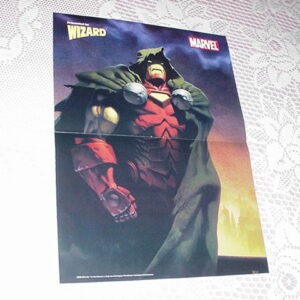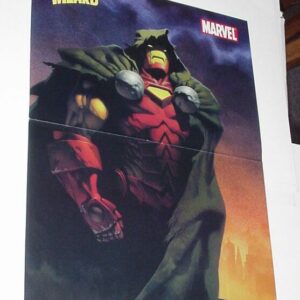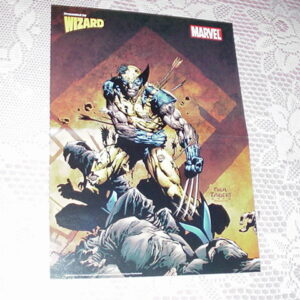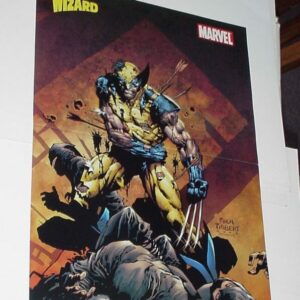Description
The Creeper matches wits with Proteus, a criminal whose changeable face makes him a master of disguise. The Creeper is a superhero who appears in comic books published by DC Comics. Created by Steve Ditko, he first appeared in Showcase #73 (March 1968). Following his debut in Showcase, the Creeper was given his own series Beware the Creeper, written by Dennis O’Neil; Steve Ditko plotted the first issue. It lasted six issues. Most pitted him against a chameleonic villain called Proteus, whose true identity was revealed just before his violent death in the final issue. The character’s reappearance in Super-Team Family #2 in 1975/76 is unexplained, and his briefly described origin does not match the one given initially.[citation needed] Shortly after his last solo issue, the Creeper teamed with Batman in The Brave and the Bold #80 (Nov. 1968), then guested in Justice League of America #70 (March 1969), where it was asked whether the Creeper was an outlaw. He also appeared with Batman in Detective Comics #418 (Dec. 1971). After the origin was reprinted in Detective Comics #443 (Nov. 1974), one of the “DC 100 Page Super Spectacular” series, Ryder was shown working as a news anchor on Gotham City television in issue #445 (March 1975), and in #447–448 (May–June 1975) became the Creeper again to help Batman escape a frame-up for murder. Jack Ryder is a former Gotham City television talk show host fired due to his outspoken nature. Finding employment in network security, he attempts to rescue a scientist named Dr. Yatz whom mobsters have kidnapped in order to obtain his newest discoveries. The chief mobster hosts a masquerade party at his mansion. To gain entry, Ryder improvises a costume from yellow tights and facial make-up designed to look like skin, a green wig and trunks, and red gloves, boots, and furry cloak. Ryder locates Yatz inside, but the mobsters detect him and open fire, wounding Ryder. Yatz injects Ryder with a serum and implants a device in his wound. The serum confers the power to almost instantly heal any wound and grants Ryder enhanced strength and agility. The device, used with its activator, causes the costume to disappear, leaving Ryder naked. Yatz inadvertently leaves the activator out of the wound, but does not realize this until after the wound had healed. At this point, the mobsters find their victims again, this time killing Yatz. Ryder discovers that with the activator, he can regain the wild costume whenever he wishes. With it, a crazy laugh and his enhanced physical abilities, he has no trouble routing the crooks. The Creeper’s powers are physical in nature and a result of Yatz’s inventions. He displays virtually superhuman agility and stamina, combined with strength. This enables him to perform amazing feats of acrobatics and leaping. He also seems to be able to climb sheer walls with little or no difficulty. His strength is enough to enable him to throw grown men several feet or jump several feet in the air. His speed and reflexes have also been enhanced greatly. These combined abilities make The Creeper a formidable fighter, incorporating brawling techniques with his physical prowess. A signature move of his is jumping onto the backs of his opponents and throwing them off balance. The Creeper also possesses a superhuman healing factor, which enables him to heal from virtually any wound; gunshots and stab wounds healing within a matter of minutes. It even allowed him to return from death when his body regenerated after being torn apart by Eclipsed hyenas. Also, his laugh is depicted as being physically painful to the ears of his victims, causing a psychotic comatose state. Stephen J. “Steve” Ditko (born November 2, 1927) is an American comic book artist and writer best known as the artist and co-creator, with Stan Lee, of the Marvel Comics heroes Spider-Man and Doctor Strange. Ditko studied under Batman artist Jerry Robinson at the Cartoonist and Illustrators School in New York City. He began his professional career in 1953, working in the studio of Joe Simon and Jack Kirby, beginning as an inker and coming under the influence of artist Mort Meskin. During this time, he then began his long association with Charlton Comics, where he did work in the genres of science fiction, horror, and mystery. He also co-created the superhero Captain Atom in 1960. During the 1950s, Ditko also drew for Atlas Comics, a forerunner of Marvel Comics. He went on to contribute much significant work to Marvel, including co-creating Spider-Man, who would become the company’s flagship character. Additionally, he created the supernatural hero Doctor Strange and made important contributions to the Hulk and Iron Man. In 1966, after being the exclusive artist on The Amazing Spider-Man and the “Doctor Strange” feature in Strange Tales, Ditko left Marvel for reasons never specified. Ditko continued to work for Charlton and also DC Comics, making major contributions, including a revamp of the long-running character Blue Beetle, and creating or co-creating the Question, the Creeper, Shade, the Changing Man, and Hawk and Dove. Ditko also began contributing to small independent publishers, where he created Mr. A, a hero reflecting the influence of Ayn Rand’s philosophy of Objectivism. Since the 1960s, Ditko has declined most interviews, stating that it is his work he offers readers, and not his personality. Ditko was inducted into the comics industry’s Jack Kirby Hall of Fame in 1990, and into the Will Eisner Award Hall of Fame in 1994. Ditko moved to DC Comics in 1968, where he created the Creeper in Showcase #73 (April 1968) with scripter Don Segall, under editor Murray Boltinoff. DC Comics writer and executive Paul Levitz observed that Ditko’s art on the Creeper stories made “them look unlike anything else being published by DC at the time.” Ditko’s stay at DC was short — he would work on all six issues of the Creeper’s own title, Beware the Creeper (June 1968 – April 1969), though leaving midway through the final one — and the reasons for his departure uncertain
Related products
-


Punisher Poster # 6 by Wieslaw Walkuski Born Frank Castle Origin Movie
$29.99 Add to cart -


Iron Man Poster # 5 by Kev Walker Iron Doom Exiles 23 Cover
$29.99 Add to cart -


Captain America Poster # 9 In Chains by John Cassaday Issue 8
$29.99 Add to cart -


Wolverine Poster #16 vs The Hand The End by David Finch Ninjas
$39.99 Add to cart



